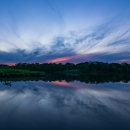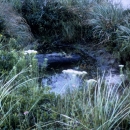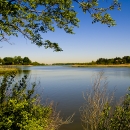Visit Us
Know Before You Go
- Open ½ hour before sunrise to ½ hour after sunset
- An entrance fee is charged:
Vehicle - $4.00
Pedestrian/bicycle - $2.00
Annual Refuge Pass (valid for 12 months from the month of purchase) - $12.00
Duck Stamp (valid July 1 to June 30) - $25.00
For groups over 12, you can request an entrance fee waiver by filling out a fee waiver form and emailing it to Ann Marie Chapman (AnnMarie_Chapman@fws.gov). - Late October through early April offer the best times to view waterfowl on the refuges. The forests come alive in spring with the arrival of warblers and other migratory songbirds, while red fox, wild turkey and white-tailed deer may greet you year-round.
- Mosquitoes and flies can be prevalent during the spring and summer. Be sure to bring bug spray.
- Poison ivy and ticks are found throughout the refuge. Stay on the trails to limit your exposure.
- Restrooms are located at the parking lot.
Points of Interest
- Hike the self-guided 1.75 mile nature trail through woodland areas and onto the beach;
- Walk the beach looking for seaside animals such as harbor seals and loons;
- Photograph wading birds from an observation blind beside a tidal lake;
- Observe a variety of songbirds, sea ducks and warblers.
Activities
Fishing
Fishing is allowed from the shoreline. A free New York state salt water fishing license is required. Common fish species include striped bass (striper or rockfish), weakfish, summer flounder (fluke), bluefish, blackfish (tautog) and porgy (scup).
Please clean your fish at home. The refuge does NOT maintain a fish cleaning station.
Wildlife Viewing
Most wildlife viewing is done from one of three hiking trails. The one mile Warbler’s Loop Trail winds through the forest that were once home to the previous owner’s formal gardens. Spring and summer showcase its magnificent beauty, while a variety of songbirds find important cover from predators and the weather. Catbirds, cardinals, common yellowthroats and Carolina wrens use the dense understory formed by azaleas, rhododendrons and yews.
An extension of the Warbler’s Loop Trail, the Rocky Beach Trail brings you down to the rocky shoreline of Long Island’s north shore.
A stroll down the shortest trail, Gardener’s Path, is where you will find interpretative signs describing the area’s wildlife species and their habitats.
Interpretation
Limited interactive, family orientated activities are offered. Please contact the headquarters office in order to set up programming for your private group. (631) 286-0485.
Environmental Education
Limited interactive, student orientated activities are offered. Please contact the headquarters office in order to set up programming for your private group. (631) 286-0485.
Photography
Nature based photography is permitted along any of the trails and along the beach. Please stay on marked trails and do not disturb resting wildlife.
Trails
Explore the Warblers’ Loop Trail (1 mile long, about an hour walk) or go down the Rocky Beach Trail (3/4 mile, about a 45 minute walk). The terrain along both trails is hilly. You can also stroll down Gardener’s Path where you will find interpretive signs describing the wildlife and wildlife habitat. Enjoy spotting warblers in the spring, sea ducks on the bay in winter, harbor seals offshore, and flowering plants and shrubs reminiscent of the Eberstadt's formal gardens.
Related Documents
Other Facilities in the Complex
The Long Island National Wildlife Refuge Complex consists of seven national wildlife refuges, two refuge sub-units and one wildlife management area wildlife management area
For practical purposes, a wildlife management area is synonymous with a national wildlife refuge or a game preserve. There are nine wildlife management areas and one game preserve in the National Wildlife Refuge System.
Learn more about wildlife management area . Collectively, the ten units are approximately 6,500 acres in size. Each unit is unique and provides a wildlife oasis amongst Long Island’s urban settings essential for the livelihood of migratory birds, threatened and endangered species, fish and other wildlife. The strategic location of Long Island in the Long Island Pine Barrens & along the Atlantic Flyway make it an important nesting, wintering and migratory stop over area for hundreds of species of birds.
Rules and Policies
Everything on the refuge is either a home or food for wildlife, so during your visit help protect wildlife by respecting the following regulations:
- Keep dogs and bikes off of refuges, their presence disturbs wildlife and poses a safety risk to other visitors;
- Take only pictures, leave only footprints;
- Respect refuge boundary signs, closed areas and private property; and
- Pack your garbage out with you.








